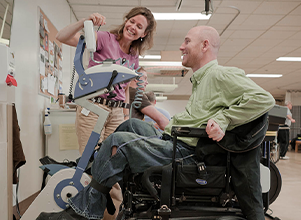Publications
Praxis is strongly committed to sharing details of the great work that is taking place throughout the SCI field. Explore SCI-related scientific papers, reports and more.

This is the breadcrumbs block. Breadcrumb will populate on actual page.
James J. Laskin, Zeina Waheed, Nancy P. Thorogood, Tom E. Nightingale, Vanessa K. Noonan
Published: February 21, 2022 DOI:https://doi.org/10.1016/j.apmr.2022.01.161
DOI: https://doi.org/10.1016/j.apmr.2022.01.161
Objectives
To describe the status of spinal cord stimulation (SCS) research for the improvement of motor, sensory, and autonomic function for individuals living with a spinal cord injury (SCI).
Data Sources
This scoping review identified original research published before March 31, 2021, via literature searches using MEDLINE, Embase, PubMed, Science Direct, Cumulative Index to Nursing and Allied Health, Sport Discus, and Web of Science, as well as a targeted search for wellknown principal investigators. Search terms included permutations of “spinal cord stimulation,” “epidural spinal cord stimulation,” “transcutaneous spinal cord stimulation,” “magnetic spinal cord stimulation,” and “neuromodulation.”
Data Extraction
Extracted data included authors, publication year, participant characteristics, purpose, study design, stimulation (device, location, parameters), primary outcomes, and adverse events.
Data Synthesis
As a scoping review the extracted data were tabulated and presented descriptively. Themes and gaps in the literature were identified and reported. Of the 5754 articles screened, 103 articles were included (55 epidural, 36 transcutaneous, 12 magnetic). The primary research design was a case study or series with only a single randomized controlled trial. Motor recovery was the most common primary outcome for epidural and transcutaneous SCS studies, whereas bowel and bladder outcomes were most common for magnetic SCS studies. Seventy percent of the studies included 10 or fewer participants, and 18 articles documented at least 1 adverse event. Incomplete stimulation parameter descriptions were noted across many studies. No articles mentioned direct engagement of consumers or advocacy groups.
Conclusions
This review identified a need for more robust study designs, larger sample sizes, comparative studies, improved reporting of stimulation parameters, adverse event data, and alignment of outcomes with the priorities of the community with SCI.
This research paper was supported by Praxis Spinal Cord Institute and Western Economic Diversification Canada.
Continue to the article.
Praxis is strongly committed to sharing details of the great work that is taking place throughout the SCI field. Explore SCI-related scientific papers, reports and more.
